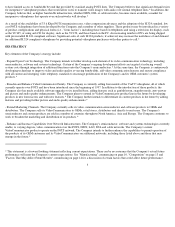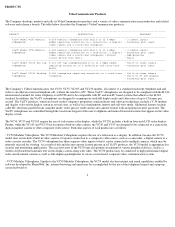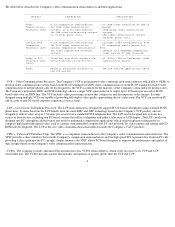8x8 1998 Annual Report Download - page 17
Download and view the complete annual report
Please find page 17 of the 1998 8x8 annual report below. You can navigate through the pages in the report by either clicking on the pages listed below, or by using the keyword search tool below to find specific information within the annual report.COMPETITION
The Company competes with both independent manufacturers of video communication semiconductors and with the introduction of its
VideoCommunicator products now competes with manufacturers of video communication products targeted at the consumer market. The
markets for the Company's products are characterized by intense competition, declining average selling prices and rapid technological change.
The competitive factors in the market for the Company's VideoCommunicators include audio and video quality, phone line connectivity at high
transmission rates, ability to connect and maintain stable connections, ease of use, price, access to enabling technologies, product design, time-
to-market, adherence to industry standards, interoperability, strength of distribution channels, customer support, reliability and brand name.
The Company expects intense competition for its VideoCommunicators from:
- Large consumer electronics manufacturers. The Company will face intense competition from many well known, established suppliers of
consumer electronics products, which may include Lucent Technologies, Matsushita, Philips, Samsung and Sony. The Company does face
competition from 3Com. Many of these potential competitors sell television and telephone products into which they may integrate video
communication systems, thereby eliminating a consumer's need to purchase a separate video communication system, such as the Company's
ViaTV product.
-
Personal computer system and software manufacturers. Potential customers for the Company's VideoCommunicators may elect instead to buy
PCs equipped with video communication capabilities, which are currently available. As a result, the Company faces or may face competition
from Intel; PC system manufacturers such as Apple, Compaq, Dell, IBM and Sony; PC software suppliers such as Microsoft and Netscape; and
PC add-on component suppliers.
- Existing manufacturers of corporate video communication equipment. Manufacturers of more expensive corporate video communication
systems have continually reduced the cost of their products and may enter the market for lower cost consumer video communication products.
Potential competitors include PictureTel, Polycom, Sony, Tandberg, VCON and Vtel.
- Emerging suppliers of internet appliances. Potential customers for the Company's VideoCommunicators may elect instead to buy standalone
internet access terminals which may provide some or all of the functionality of the Company's products. Consumer products for television-
based internet access have been announced or introduced by companies such as Microsoft, Philips and Sony.
C-Phone, Leadtek, 3Com and Truedox are among the companies selling low cost videophones. Many other companies have announced the
development of low cost videophones. The Company expects that additional companies will introduce products that compete with the
VideoCommunicators in the future. Certain manufacturers or potential manufacturers of low cost videophones have licensed or purchased, or
may license or purchase, the Company's technology and semiconductors in order to do so. KME and 3Com in particular have licensed
substantially all of the technology underlying the VideoCommunicators, and may use such technology to introduce products that compete with
the VideoCommunicators. Each of Leadtek and Truedox license the Company's technology and purchase the Company's video communication
semiconductors. The Company aggressively licenses its semiconductor, software and systems technology and sells its semiconductor and
system products to third parties. Thus, it is likely that additional of the Company's OEM customers will become competitors with respect to the
Company's VideoCommunicator business. Other competitors may purchase video communication semiconductor and related technology from
other suppliers.
The principal competitive factors in the market for video communication semiconductors include product definition, product design, system
integration, chip size, functionality, time-to-market, adherence to industry standards, price and reliability. The Company has a number of
competitors in this market including Analog Devices, Chromatic Research, Lucent Technologies, Motorola, Philips, Texas Instruments and
Winbond Electronics. Potential competitors include ESS Technology, which has licensed certain of the Company's video communication
semiconductor technology, and Rockwell Semiconductor Systems. Certain of the Company's competitors for video communication
semiconductors maintain their own semiconductor foundries and may therefore benefit from certain capacity, cost and technical advantages. In
addition, the presence of
13
























